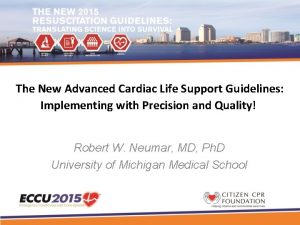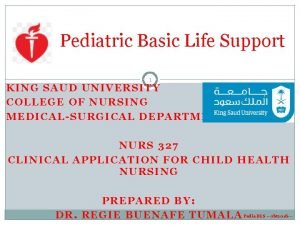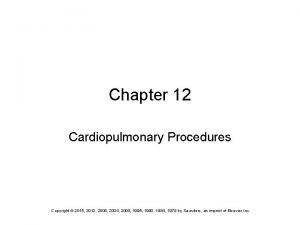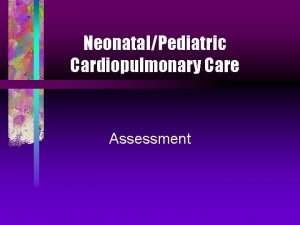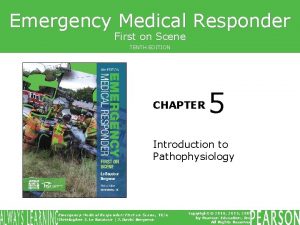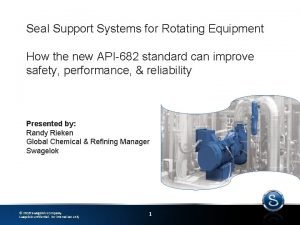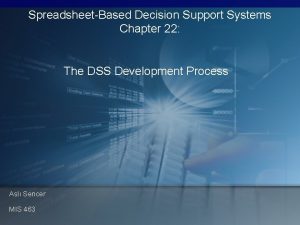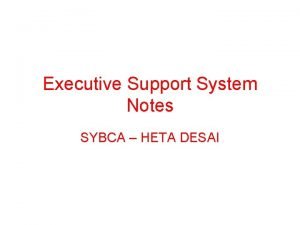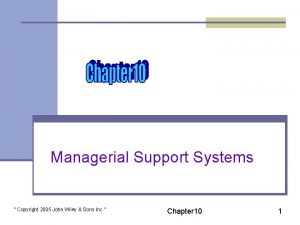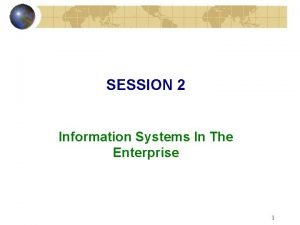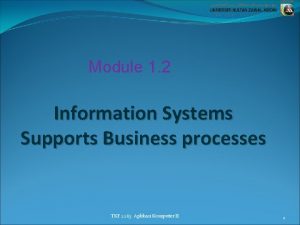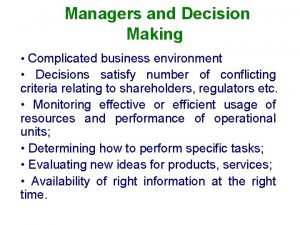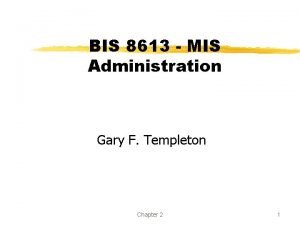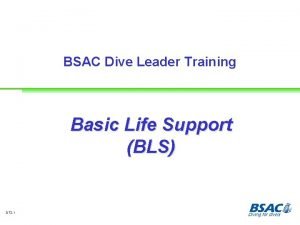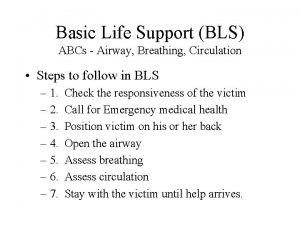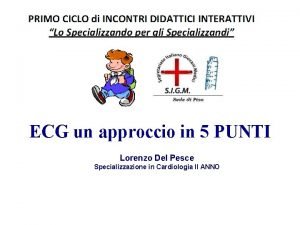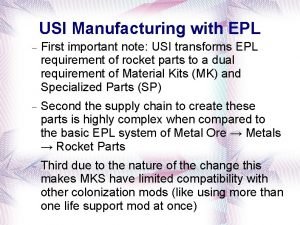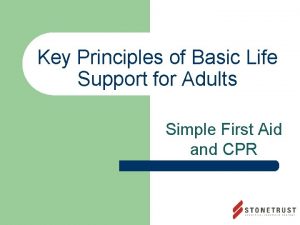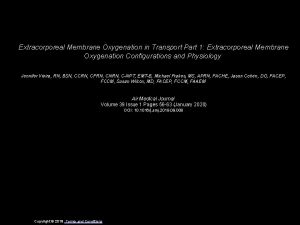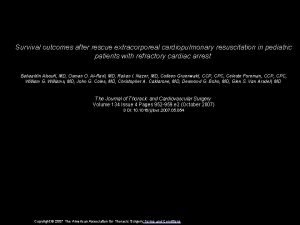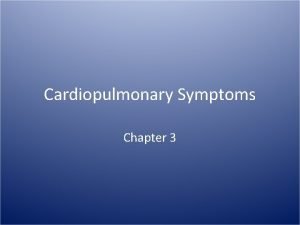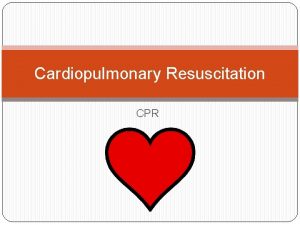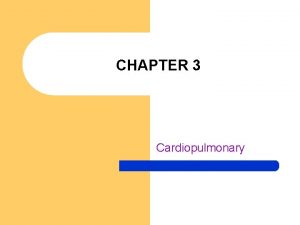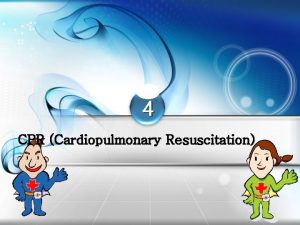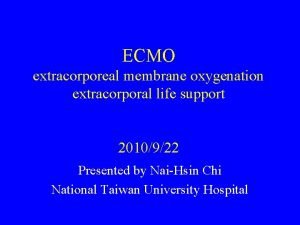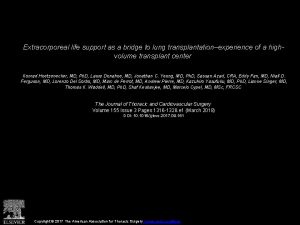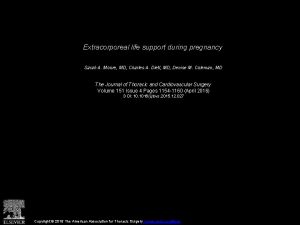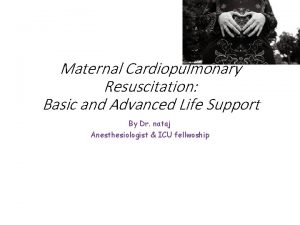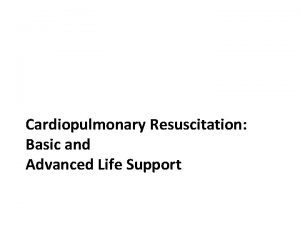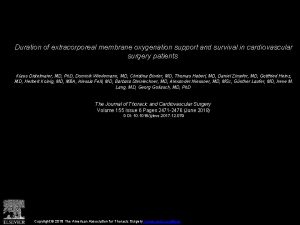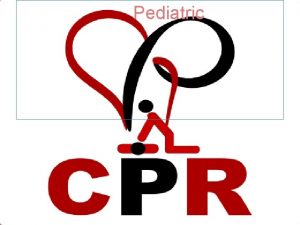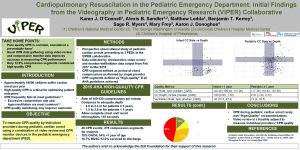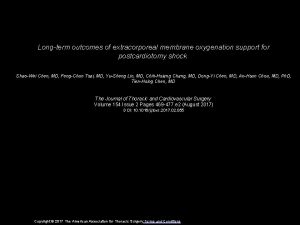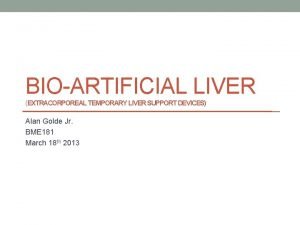Pediatric extracorporeal life support systems and Pediatric cardiopulmonary










































- Slides: 42

Pediatric extracorporeal life support systems and Pediatric cardiopulmonary perfusion systems: Now and future Asist. Prof. Dr. Tolga KURT Canakkale Onsekiz Mart University Turkey International Conference and Exhibition on Pediatric Cardiology August 25 -27, 2015 Valencia

Background - History CPB ECMO‐ECLS VAD TAH

The first heart-lung machine (HLM) which was made by Gibbon CPB ECMO‐ECLS VAD TAH

The new HLM machines

One of the first machines and surgical team

Now

Differances between pediatric and adult Cardiopulmonary Perfusion Pediatric organ sytems are not developed sufficiently as adults. The size of the organs are smaller than the adults The rate of metabolism is higher than adults ↔ higher perfusion rate is needed. The frequent need of intracardiac access Presence of abnormal anatomy and physiology

Differances between pediatric and adult cardiopulmonary bypass (CPB) procedures Extreme hypothermia, hemodilution and perfusion flow rate values Pathological anatomy operation technical changes CPB circuit extremely large compared to body mass index The prime volume is more than the total blood of newborns and infants. Large body mass index differences observed in the cases selection of appropriate materials required in each case.

Pediatric CPB Complications ↑↑↑↑↑ We must lower the prime volume ↓ We must lower the surface area which the blood contacts. ↓ We must reduce the size of the circuit components ↓

Prime Volume Adults 25 -30 % Of the total blood volume Neonates 2 -3 times Of the total blood volume To prevent excessive hemodilution Donor blood can be add to prime volume

Sanguineous prime volume Blood-borne infections Reinforcement of inflammatory reaction Transfusion-induced acute lung injury Pulmonary hypertension The organ perfusion disorders due to rheological properties Low cardiac index

Our Target : Lower prime oxygenator volume Reducing the size of the venous line Reducing the size of the circuit Arterial line filter Venous Reservoir Level ↓↓↓↓ The circuit prime volume reduction and non sanguineous prime volume

ALF: Arterial line filter Mc. Robb CM, Mejak BL, Ellis WC, Lawson DS, Twite MD. Recent Advances in Pediatric Cardiopulmonary Bypass. Semin Cardiothorac Vasc Anesth. 2014; 18(2): 153– 60.

Pediatric CPB pumps Roller Pumps Centrifugal Pumps

Roller Pumps +++ With small diametered lines, the prime volume is low +++ Sensitive flow control even at low flow rates --- Hemolysis or damage to the other formed elements of the blood --- Roller pump induced tubing tear of polyvinylchloride and silicone rubber tubing --- Inability to provide appropriate position The new generation heart lung machine can be given the required position.

Centrifugal Pumps +++ More mobile +++ Less hemolysis or damage to the other formed elements of the blood +++ Reducing the flow line to prevent the high pressure in arterial line obstructions --- High prime volume --- Insufficient sensitivity at low flow rates

New generation centrifugal pumps Prime volume (ml) Max Flow (L/min) Connector Medos Deltastream DP 3 16 8 3/8” Medos s. pump 17 8 3/8” Levitronix Centri. Mag 31 10 3/8” Maquet ROTAFLOW 32 10 3/8” Medtronic Affinity CP 40 10 3/8” Terumo CAPIOX SP 45 8 3/8” Medtronic BP‐ 50 Bio‐Pump 48 1. 5 1/4” Sarns disposable centrifugal pump 48 10 3/8” Sorin Rev. Olution 52 8 3/8”

Pediatric Oxygenators Structure Holow fiber Gas exchange surface porous polypropylene Gases transmit from the pores through blood Erythrocytes and plasma does not transmit !!

Pediatric Oxygenators Wide temperature range (10 °C - 40 °C) Wide flow range (0 - 200 ml / kg / min) Htc wide range (15% - 40%) Wide range of line pressure Wide gas flow range ↓↓↓↓ Despite its small surface area, effective gas exchange, even at high flow.

Pediatric Oxygenators Priming volume (ml) Surface area (m 2) Max Flow (L/min) Sorin D 100 Kids 31 0. 22 0. 7 Maquet QUADROX‐i Neonatal 38 Terumo CAPIOX Baby. Rx 43 0. 38 0. 50 1. 5 Medtronic Affinity Pixie 48 Medos Hilite 1000 57 Sorin Lilliput I 60 Maquet QUADROX‐i Pediatric 81 Sorin D 101 Kids 87 Medos Hilite 2800 98 0. 67 0. 39 0. 34 0. 80 0. 61 0. 80 2 1 0. 8 2. 5 2. 8 2. 3 Medtronic. Minimax Plus 149

Pediatric Tubing Sets Tubing sets 75 % of the prime volume The most important step in reducing the tubing set volume Reducing the length and diameter of the tubing set: ------Approximation of the pump to the patient about 29% reduction in the volume of prime Tubing set diameter reduction the resistance to flow increase assisted venous drainage Shortening of the tubing set decrease of the resistance

Pediatric Arterial Filters Disadvantages: ----High prime volume ----A large foreign surface ----The difficulty of removing the air bubbles Pediatric Arterial Filters Priming volume (ml) Max Flow (L/min) Pore (µm) Sorin D 130 Kids ALF 16 0. 7 40 Sorin D 131 Kids ALF 28 2. 5 40 Medtronic Affinity Pixie ALF 39 3. 2 Terumo CAPIOX ALF AF 02 40 2. 5 30 32

Integrated products Only reducing the component size insufficient to reduce prime volume We need integrated component products oxygenator + arterial filter Priming volume (ml) Max Flow (L/min) Pore (µm) Maquet QUADROX‐i Neonatal 38 1. 5 33 Terumo CAPIOX FX 05 43 1. 5 32 Maquet QUADROX‐i Pediatric 81 2. 8 33 Terumo CAPIOX FX 15 144 5. 0 32

Integrated products No need for an extra prime volume for the arterial filters The captured gas bubbles are transferred to the oxygenator gas reservoir by the pressure difference. Particulate emboli capture efficiency is similar to standard filters Gas emboli capture efficiency is higher than standard filters

Pediatric cardioplegia Standard blood cardioplegia Del Nido cardioplegia Crystalloid cardioplegia ------St. Thomas solution ------Custodiol (Histidine-Tryptophan. Ketoglutarate) Microplegia ------Quest Biomedical MPS 2 Myocardial Protection System (prime 7 -35 m. L)

Pediatric Ultrafiltration It has a porous hollow fiber structuremade with polysulfone, molecules Weighting <50 -65 k. Da can pass. Aim: Reduction of Edema Raising hematocrit values Removal of electrolyte (potassium) Removal of Inflammation mediators, lactate and citrate

Pediatric Ultrafiltration Prime(ml) Medivator Hemocor HPH Jr 8 Medivator Hemocor HPH Mini 14 Maquet BC 20 Plus 17 Medos Hemofilter Pro 20 17 Sorin Dideco DHFO. 2 Hemoconcentrator 30 Medivator Hemocor HPH 400 34 Terumo CAPIOX Hemoconcentrator 35 Medos Hemofilter Pro 60 52 Maquet BC 60 Plus 65

ECMO‐ECLS (Extracorporeal Membrane Oxygenation - Extra. Corporeal Life Support) The aim is to provide sufficient time and appropriate environment for the restoration of myocardial and lung damage. ECLS -----ECMO ----ECCO 2 R (Extracorporeal carbon dioxide removal ) ----VAD (ventricular assist device )

ECMO‐ECLS

ECMO PUMPS Roller pumps are the most commonly used. ++++ Inexpensive ++++ Reliable ++++ Laminar flow ----- Hemolysis ----- Spallation and tube rupture Spallation : The sloughing off of plastic and silastic tubing particles into the lumens of tubing through the erosive and fatiguing action of rollers in the pump head.

Spallation and tube rupture

ECMO PUMPS To prevent excessively high and low pressure formation continuous measurement of arterial and venous pressure line Prime volume (m. L) Connector Medtronic Bladder Reservoir R‐ 14 35 1/4” Medtronic Bladder Reservoir R‐ 38 35 3/8”

ECMO PUMPS Centrifugal Pumps: ++++ Less traumatic to blood cells ------ Sensitive preload and afterload ------ Insufficient flow due to the high internal resistance of the silicon membrane oxygenators. ------ The risk of thrombosis in long-term use (5 -7 days).

ECMO Oxygenators Porous polypropylene hollow fiber oxygenators In long-term use: wetting of the membrane structures, leakage of plasma, dysfunction. For long-term usage non-porous silicon membrane oxygenators There are no holes in the silicon membrane. Gases diffuse through the blood from the silicon

ECMO Oxygenators Spiralcoiled structure high resistance to blood flow blood oxygenator transition speed slows down and increases gas transfer Internal heat exchanger available also adding circuit heat exchanger unit increase in the prime volume of the system Silicone membrane oxygenators Avecor/Medtronic 0800 Avecor/Medtronic 1500 Prime volume (m. L) Surface area (m 2) Max Flow (L/min) 100 175 0. 8 1. 5 1. 2 1. 8

ECMO Oxygenators Polymethylpentene porous hollow fiber oxygenator: +++++Long-term use (up to 2 weeks) No largely plasma leakage +++++ Internal heat exchanger No increase in prime volume +++++ Centrifugal pump usage according to their low internal resistance

ECMO Oxygenators Prime volume (m. L) Surface area (m 2) Max Flow (L/min) Medos Hilite 800 LT 55 0. 32 0. 8 Eurosets ECMO NEW BORN 90 0. 69 1. 5 Medos Hilite 2400 LT 95 0. 65 2. 4 Sorin EOS ECMO 150 1. 2 5 Maquet QUADROX‐i. D ECMO 250 1. 8 7 Polymethylpentene oxygenator

ECMO Heat Exchangers Newborn ECMO thermoregulation ability is underdeveloped Prime volume (m. L) Max Flow (L/min) Gish Biomedical HE‐ 3 20 2 Medtronic ECMOtherm II HE 50 2 Gish Biomedical HE‐ 4 60 2

ECMO Tubing Sets DEHP in PVC tubes (di (2 -ethylhexyl) phthalate) infertility in long-term usage No abnormalities in clinical development for patients ECMO with the roller pump PVC tube line in the pump head spallation and tube rupture Tygon S-65 HL tubes are more resistant to spallation and tube rupture, they can be preferred.

Pediatric circulatory support Short-term (<30 days) assistance ECMO, centrifugal pump or roller pump Long-term assistance Ventricular assist devices (VAD): Parakorporeal pneumatic pulsatile VAD Newborns and infants Berlin Heart, Medos HIA VAD Adolescents Thoratec VAD, Heartmate VAD Axial flow devices Micro. Med/De. Bakey VAD

Good luck to all of our children, and Godspeed in now and future. Thank You…

References 1. Van Doorn C, Elliott M. Cardiopulmonary Bypass in Children with Congenital Heart Disease. In: Kay PH, Munsch CM, editors. Techniques in Extracorporeal Circulation. 4 th ed. London: Arnold; 2004. p. 177– 83. 2. Giacomuzzi C, Brian M, Shen I. Pediatric Cardiopulmonary Bypass Overview: State of the Art and Future. In: Gravlee GP, Davis RF, Stammers AH, Ungerleider RM, editors. Cardiopulmonary Bypass: Principles and Practice. 3 rd ed. Philadelphia: Lippincott Williams & Wilkins; 2008. p. 686– 700. 3. Charette KA, Davies RR, Chen JM, Quaegebeur JM, Mosca RS. Pediatric Perfusion Techniques for Complex Congenital Cardiac Surgery. In: Mongero LB, Beck JR, editors. On Bypass: Advanced Perfusion Techniques. New Jersery: Humana Press Inc. ; 2008. p. 29– 58. 4. Mc. Robb CM, Mejak BL, Ellis WC, Lawson DS, Twite MD. Recent Advances in Pediatric Cardiopulmonary Bypass. Semin Cardiothorac Vasc Anesth. 2014; 18(2): 153– 60. 5. Chai PJ. Myocardial Protection and Preservation for Neonates and Infants. In: Gravlee GP, Davis RF, Stammers AH, Ungerleider RM, editors. Cardiopulmonary Bypass: Principles and Practice. 3 rd ed. Philadelphia: Lippincott Williams & Wilkins; 2008. p. 701– 10. 6. Turkoz R. Myocardial protection in pediatric cardiac surgery. Artif Organs. 2013; 37(1): 16– 20. 7. Kotani Y, Tweddell J, Gruber P, Pizarro C, Austin EH, Woods RK, et al. Current cardioplegia practice in pediatric cardiac surgery: a North American multiinstitutional survey. Ann Thorac Surg. 2013; 96(3): 923– 9. 8. Hickey EJ, Karamlou T, Ungerleider RM. Brain Injury Following Infant Cardiac Surgery and Neuroprotective Strategies. In: Gravlee GP, Davis RF, Stammers AH, Ungerleider RM, editors. Cardiopulmonary Bypass: Principles and Practice. 3 rd ed. Philadelphia: Lippincott Williams & Wilkins; 2008. p. 711– 35. 9. Searles B, Darling E. Ultrafiltration in Cardiac Surgery. In: Mongero LB, Beck JR, editors. On Bypass: Advanced Perfusion Techniques. New Jersery: Humana Press Inc. ; 2008. p. 193– 210. Mc. Mullan DM, Elliot MJ, Cohen GA. ECMO for Infants and Children. In: Gravlee GP, Davis RF, Stammers AH, Ungerleider RM, editors. Cardiopulmonary Bypass: Principles and Practice. 3 rd ed. Philadelphia: Lippincott Williams & Wilkins; 2008. p. 736– 56. 11. Khan S, Vasavada R, Qiu F, Kunselman A, Undar A. Extracorporeal life support systems: alternative vs. conventional circuits. Perfusion. 2011; 26(3): 191– 8. 12. Ravishankar C, Gaynor JW. Circulatory Assist Devices for Infants and Children. In: Gravlee GP, Davis RF, Stammers AH, Ungerleider RM, editors. Cardiopulmonary Bypass: Principles and Practice. 3 rd ed. Philadelphia: Lippincott Williams & Wilkins; 2008. p. 757– 66.
 Extracorporeal cpr
Extracorporeal cpr Pediatric life support algorithm
Pediatric life support algorithm Pediatric life support algorithm
Pediatric life support algorithm Pediatric emergency life support
Pediatric emergency life support Crossword puzzle cardiopulmonary procedures
Crossword puzzle cardiopulmonary procedures Moro reflex
Moro reflex Cardiopulmonary
Cardiopulmonary Chapter 17:10 providing first aid for specific injuries
Chapter 17:10 providing first aid for specific injuries Basics of word building and pronunciation
Basics of word building and pronunciation Cardiopulmonary circulation
Cardiopulmonary circulation Decision support systems and intelligent systems
Decision support systems and intelligent systems Eolss
Eolss Grammatical signals examples
Grammatical signals examples Decision support and business intelligence systems
Decision support and business intelligence systems What is decision support system in business intelligence
What is decision support system in business intelligence Decision support and expert systems
Decision support and expert systems Seal support system requirements
Seal support system requirements Developing spreadsheet-based decision support systems
Developing spreadsheet-based decision support systems Management support systems
Management support systems Executive support systems
Executive support systems Managerial support systems
Managerial support systems Executive support systems
Executive support systems Executive support systems
Executive support systems Types of decision making
Types of decision making Executive support systems
Executive support systems Executive support systems
Executive support systems Executive support systems
Executive support systems Professional support system
Professional support system 5ps of international business
5ps of international business Basic life support sequence
Basic life support sequence Bls steps
Bls steps Advanced life support
Advanced life support Battiti ectopici ventricolari forum
Battiti ectopici ventricolari forum National disaster life support foundation
National disaster life support foundation Usi life support
Usi life support Life support
Life support Life support alliance
Life support alliance National disaster life support foundation
National disaster life support foundation Dicapine
Dicapine Embedded systems vs cyber physical systems
Embedded systems vs cyber physical systems Engineering elegant systems: theory of systems engineering
Engineering elegant systems: theory of systems engineering Vocabulary city life
Vocabulary city life Life orientation skills
Life orientation skills
